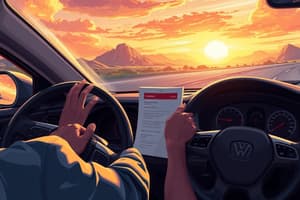Podcast
Questions and Answers
If a company's current ratio is 1.5, which of the following actions would most likely decrease the current ratio?
If a company's current ratio is 1.5, which of the following actions would most likely decrease the current ratio?
- Selling marketable securities at a loss.
- Borrowing short-term to finance additional inventory. (correct)
- Using cash to pay off accounts payable.
- Collecting accounts receivable faster than previously.
A company has a debt-to-equity ratio of 0.5. What is the equity multiplier for this company?
A company has a debt-to-equity ratio of 0.5. What is the equity multiplier for this company?
- 1.0
- 0.5
- 2.0
- 1.5 (correct)
Which of the following would not be considered a method to improve a company's inventory turnover ratio?
Which of the following would not be considered a method to improve a company's inventory turnover ratio?
- Implementing a just-in-time inventory management system.
- Writing down obsolete inventory.
- Increasing the production of goods to meet anticipated demand. (correct)
- Negotiating better terms with suppliers to reduce inventory holding costs.
A company's net profit margin is 10% and its total asset turnover is 2.0. What is the company's return on assets (ROA)?
A company's net profit margin is 10% and its total asset turnover is 2.0. What is the company's return on assets (ROA)?
Which of the following best describes the purpose of a common-size balance sheet?
Which of the following best describes the purpose of a common-size balance sheet?
Flashcards
Character
Character
A basic unit of data in computing, it can be a single letter, number, or symbol.
String
String
A sequence of characters, such as letters, numbers, and symbols, that represents text.
Variable
Variable
A named storage location in a computer's memory that can hold a value.
Boolean Value
Boolean Value
Signup and view all the flashcards
Operator
Operator
Signup and view all the flashcards
Study Notes
-
GDL drivers are required to make certain all passengers wear seatbelts in their vehicle.
-
Violating seat belt laws means a primary offense for front seat passengers.
-
Three benefits of wearing a seatbelt in a crash:
-
Keep passengers inside the vehicle
-
Decelerate the body with the vehicle
-
Restrain passengers during sudden stops
-
Infants in rear-facing seats should be buckled in the back seat of the vehicle, in the middle seat if possible.
-
Not removing snow from a vehicle in winter can result in a fine of $25-$75.
-
Fines up to $1,500 can be assessed if dislodged snow or ice causes property damage or injury.
-
95% is the percentage of the information gotten while driving that is visual.
-
A blind spot or “no zone” is area around vehicle not seen through the mirrors.
-
New Jersey law states that you must restrict vehicle idling to three minutes or less.
-
Idling over three minutes, results in fines from $250-$1,000.
-
A vehicle’s health and driver’s health will be negatively impacted by idling more than 3 minutes when not stuck in traffic.
-
9 and 3 o'clock are the most commonly accepted hand positions for steering a vehicle.
-
Gripping the steering wheel prevents injury if the airbag deploys.
-
A vehicle’s stopping distance depends on factors like:
-
Motorist reaction time
-
Weather and visibility
-
Vehicle weight
-
Brake conditions
-
Tire conditions and type
-
Roadway conditions
-
Speed
-
Time is not a determining factor of vehicle stopping distance.
-
At a speed of 60 mph, a car needs a football field length to stop when traveling.
-
A driver can calculate total stopping distance by combining perception distance, reaction distance, and braking distance.
-
A driver must use the turn signal when:
-
Turning at an intersection
-
Changing lanes
-
Stopping
-
Slowing down
-
At least 100 feet before turning signal your intentions.
-
Cancel the signal after making a turn.
-
Slowing or stopping proper signal: hand and arm extend downward, with palm facing the rear.
-
Making a proper right-hand turn signal: hand and arm extending upward.
-
Making a proper left-hand turn signal: hand and arm extending straight out to the left.
-
Drivers can communicate through:
-
Horn
-
Headlights
-
Turn signals
-
Brake lights
-
Hand signals
-
Backing technique, ensure path is clear, foot brake at 12 o'clock, shirt reverse, right hand seat over right, shoulder back window, release brake control roll wheel, roll hand to top, keep backwards direction until stopped
-
When parking downhill without a curb: turn wheels to the right to avoid rolling into traffic.
-
When parking downhill with a curb: wheels toward the curb, set brake, put vehicle in park, or reverse for manual.
-
When parking uphill with no curb: turn front wheels right, so it rolls away from the road.
-
When parking uphill with a curb: turn front wheels left, allow car to roll back until tire touches the curb.
-
Parallel parking requires the most practice for new drivers.
Studying That Suits You
Use AI to generate personalized quizzes and flashcards to suit your learning preferences.




